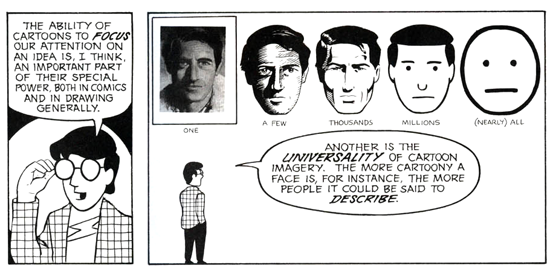Coming from reading Shaun Tan's The Arrival, I would say I was feeling a bit more in tune with the subtle nuance of illustration, framing and other unspoken narrative. Really diving in and finding those different complex meanings and themes that riddle the page and ring strong and true without speaking a single word. Then none of that mattered with this week's assignment.
Scott McCloud's Understanding Comics touches on a lot of really solid points of the understanding comics in a very informative . What I found really interesting are the connections he made on a both broad and personal level. Being able to tie in both a large ideas of what comics are as sequential art down to the mastery of understanding the human mind to connect to the characters in the comics. What most resonated with me was the idea that McCloud related on icons and universality of it.
The idea of iconography isn't new to me. I understand creating images to relate ideas and themes, to send a message that can be universally understood and/or recognized. But the idea of connecting to that message through a personal relation is something I never really picked up on till now. Humanity's self love fueling a relationship and understanding with lifeless or inanimate objects is just so absurdly correct, insightful and makes total sense. Whats really great is the idea of this universality relates to all ages, although I'd say the younger you are the more attuned you are to these feelings.
Thursday, August 29, 2013
Wednesday, August 21, 2013
Shaun Tan's The Awakening
Shaun Tan's The Arrival was a very different graphic novel than what I'm normally used to. It being without speech, for one, gave me somewhat of an incite in universal theme-ing that I'm not always paying complete attention to. Specifically, with text based stories, I find myself wrapped up in the literary aspect; pulling at the different strings of reference to come to conclusions of tone and meaning. With The Arrival, I found myself more gravitating to the imagery, of course, and the archetypal characters and themes. For instance, the allusion of immigration gave me a lot familiar ideas to grasp onto without needing the idea of direct speech handing me the answer, specifically story-wise. Although, at some points in the story I feel as if the metaphor was forced a little to hard as a result of relying so hard on image. Specifically when the father was going through his things when he was in his room and there was a frame of his family in the suitcase. Its pretty obvious what the idea is there, and if it weren't for the overall somewhat whimsical tone of the story, it would be completely out of place for me. The tone, also being somewhat strangely optimistic and simple also through me off somewhat in contrast to the hectic and loaded flashbacks of the characters.
I think having text in this specific story may have taken more away than what it may have added. Again, I would try to find some deeper meaning hidden in the obvious extended metaphor but really just miss the beautiful simplicity of the story. But more importantly, I think the story of immigration and that language barrier inherent adds to the luster of this commutation style in a way text would only detract from. The simple things like having the father communicate with an image in the story itself cements this idea pretty perfectly. I would struggle to find a better example or reason to have a speechless story than what Tan has shown
us here.
I think having text in this specific story may have taken more away than what it may have added. Again, I would try to find some deeper meaning hidden in the obvious extended metaphor but really just miss the beautiful simplicity of the story. But more importantly, I think the story of immigration and that language barrier inherent adds to the luster of this commutation style in a way text would only detract from. The simple things like having the father communicate with an image in the story itself cements this idea pretty perfectly. I would struggle to find a better example or reason to have a speechless story than what Tan has shown
us here.
Subscribe to:
Posts (Atom)

